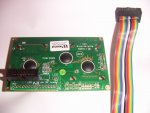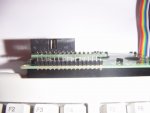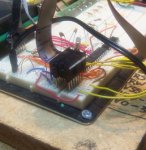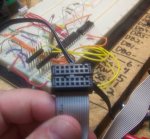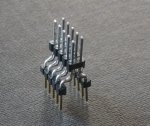I'm not sure such a thing exists without soldering. In other words a SIL to ribbon cable connector that is IDC. Essentially you only get every alternate wire connected as the ribbon wire spacing is 0.05".
I came across this problem about 6 months ago (and suggestions would be gratefully received!) where I wanted to connect a ribbon cable to a 16 way SIL on an LCD display via a socket. Soldering the wires became tedious and there was also the issue of plugging it in the wrong way, or with 1 pin offset. I found the hard way both of those mistakes zaps an LCD display. So I ended up making some little PCBs that convert 16 way SIL to a 2x8 way header. A 2x8 header comes in a box version which you simply can't plug in the wrong way. 2x8 headers also come with IDC for the cable part. So you can solder a SIL 16x1 header onto the LCD display, then solder on the adaptor PCB and put a 2x8 box header on that PCB. Use a 2x8 on the other end with the picaxe or other board. Then make up some short cables using IDC connectors. Now I can mix and match different LCD displays easily, eg swap in 8x2 or 16x2 or 20x2 or 20x4. As many on this forum will know, LCD displays use very similar code so swapping in different displays will still work (generally you just can't see some letters on the smaller ones).
For connecting onto a breadboard, I need to go back and read the threads above more thoroughly as someone may have already mentioned it, but back in the olden days Tandy (Radio Shack) sold an IDC connector that converted ribbon cable into a package that was the same size as an IC (I think it was 16 pin). That would fit onto a breadboard. I haven't seen them around for a while though, and I'm not sure what they are called.
See the side view - this would fit perfectly into a breadboard.
Hmm, I wonder if there is a market for tiny PCBs that convert SIL to box headers??

